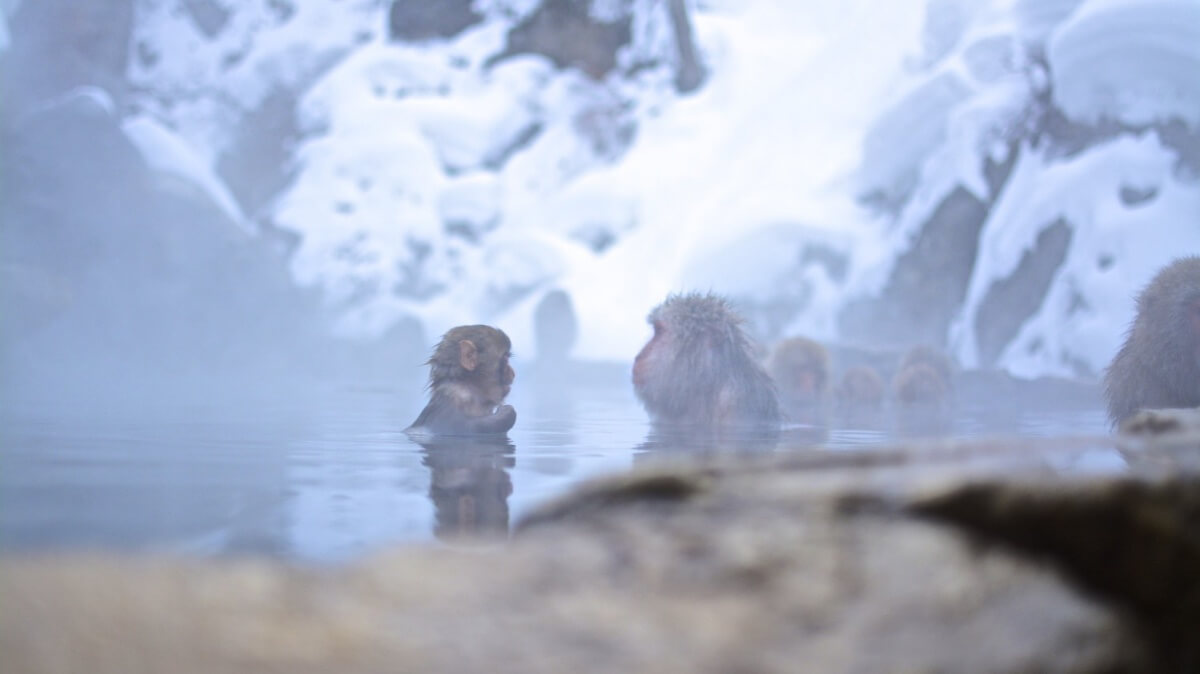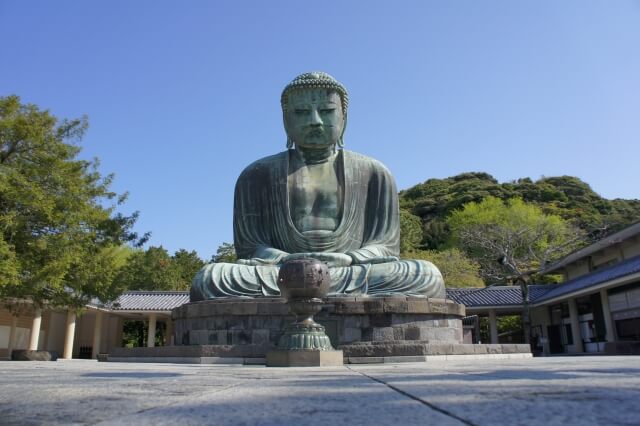Have you seen enough of Japan’s busiest cities and do you want to explore some nature? Go visit the snow monkeys in the mountains of Nagano Prefecture. On top of witnessing an amazing natural ecosystem, experience traditional Japanese inns (ryokan) and their hot springs (onsen).
Japan is not known for its wildlife. True, there are relatively few animals to be seen in Japan and most travelers tend to stick in the cities with the JR Pass so there are few opportunities to encounter wild animals anyways. But that doesn’t mean that the little fauna to see is not amazing; meet the famous snow monkeys!
The Japanese Macaque, better known as the snow monkey, is a native species and lives in the mountains of the Nagano prefecture. These monkeys are regularly featured in nature magazines and documentaries as they are incredibly photogenic in their snowy environment. They survive the tough winters (sub-zero temperatures) by grouping around natural hot springs, which are not easily accessed by foot. This is why in the Snow Monkey Park of Jigokudani, there is a man-made hot spring where a large population of monkeys come to bathe. Here is all the info you need for a magical trip to meet the snow monkeys.
The Snow Monkey Park
Jigokudani Wild Monkey Park is located in Yamanouchi, Nagano Prefecture. It is famous for its heavy snowfalls and its large population of wild Japanese macaques, the snow monkeys. What makes this place unique is that the snow monkeys go down to the valley during the winter and sit in the warm waters of the onsen (hot springs of Japan). The temperature drops to -10 degrees and the snow easily reaches a height of one meter.
When is the time to visit the snow monkeys?
The season to visit the snow monkeys is December to March, exactly, when there is snow. January and February are the top options, with the highest chance of snow! The Snow Monkey Park is open every day from 9am until 4pm. It is open all year round, but the snow monkeys aren’t snow monkeys when it’s June! Also, chances are that the monkeys stay up in the mountains outside of the cold, snowy winter months.
We recommend you to get to the park early, around 9am, especially in the snowy season as later in the day it will be (very) busy with tourists that all want to see the monkeys and shoot the most amazing wildlife photos. Provided the hotel shuttles you to the entrance of the park, you will be dropped off at the bottom of the trek to the hot spring.
Even though it is a pleasant 45-minute walk in the beautiful mountain scenery, you will have to do quite a bit of hiking. The sign at the entrance tells you that it takes approximately 25 minutes to get to the park, it might actually take longer due to the icy ground and of course, depending on each individual. Most people walk in 45 minutes, including some photo stops, so plan your time wisely! Also, dress accordingly, you will be out in the cold for at least a few hours.
Upon arriving at the entrance to the hot spring, you will have to pay ¥800 for your entrance ticket. You then proceed to see the monkeys bathing in the hot spring. What makes it all the funnier is the resemblance between the monkeys and humans. While you may not touch the monkeys (please don’t!) they are used to human presence and aren’t scared to come close to you and your camera, giving you the freedom of taking close-up photos to your heart’s content. A visit to the snow monkeys is a guaranteed amazing viewing experience!
Opening times of the Snow Monkey Park
Winter season (Nov – Mar): 9am – 4pm
Summer season (Apr – Oct): 9am – 5pm
Getting to the Snow Monkey Park
From Tokyo, you take the Shinkansen to Nagano station. For those of you who have the JR Rail Pass, the Shinkansen is covered by the JR Rail Pass. From Nagano station, you’ll take a 40-minute bus ride to the Snow Monkey Park. As many as 10 buses depart each day for the park and the bus ride costs ¥1,400. Alternatively, you can take the Nagano-sen (Nagaden) train to Yudanaka Station, though, you will still need to take the bus or train to reach the Snow Monkey Park.

Accommodation near the Snow Monkey Park
Yudanaka is a small mountain village with many ryokan (Japanese-style hot spring hotels) varying in price from ¥4,000 – ¥10,000 per person per night. During your trip to Japan, you should stay at least once in a ryokan!
Most ryokan include a yukata (traditional Japanese light kimono) you can wear and free hot springs (separated by gender, full nudity is required). The food is typically traditional (local) Japanese and served in the room whose floor is covered entirely with tatami mats upon which you have a futon to sleep. In Yudanaka, most ryokan offer shuttle services to and from the monkey park included in the price, inquire with the hotel though to be sure.
Our hotel recommendations
- Aburaya Tousen
Luxurious Japanese-style accommodation with 11 (!) onsen - Onyado Hishiya
Japanese-style ryokan with both indoor and outdoor baths - Hotel Omodake
Large Japanese style rooms and both Japanese and continental breakfast
For many, seeing the snow monkeys bathing in the hot spring is a highlight of their trip to Japan. More than the overall beauty of the natural park and the animals themselves, seeing monkeys bathe and play in hot springs will make you happy and amazed. The area of Nagano is an amazing place that will be a guaranteed special experience. If you are interested in visiting the area, read our blog about top highlights in Nagano prefecture.
Follow us on Instagram or Facebook for more travel inspiration. Or tag us to get featured!
Happy traveling!
Other articles you might enjoy
This post may contain some affiliate links. When you click through and make a purchase we may receive some commission, at no extra costs to you.




